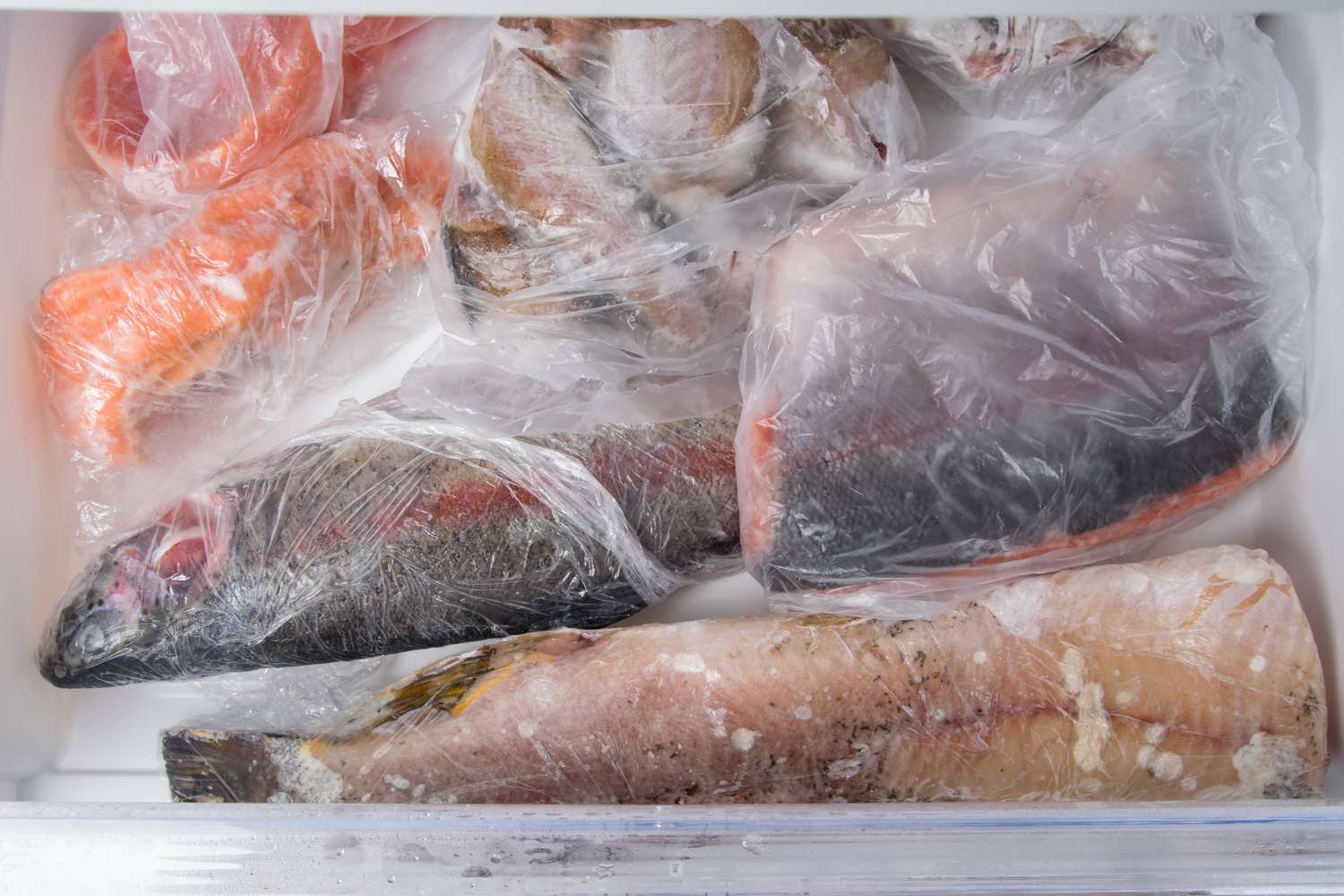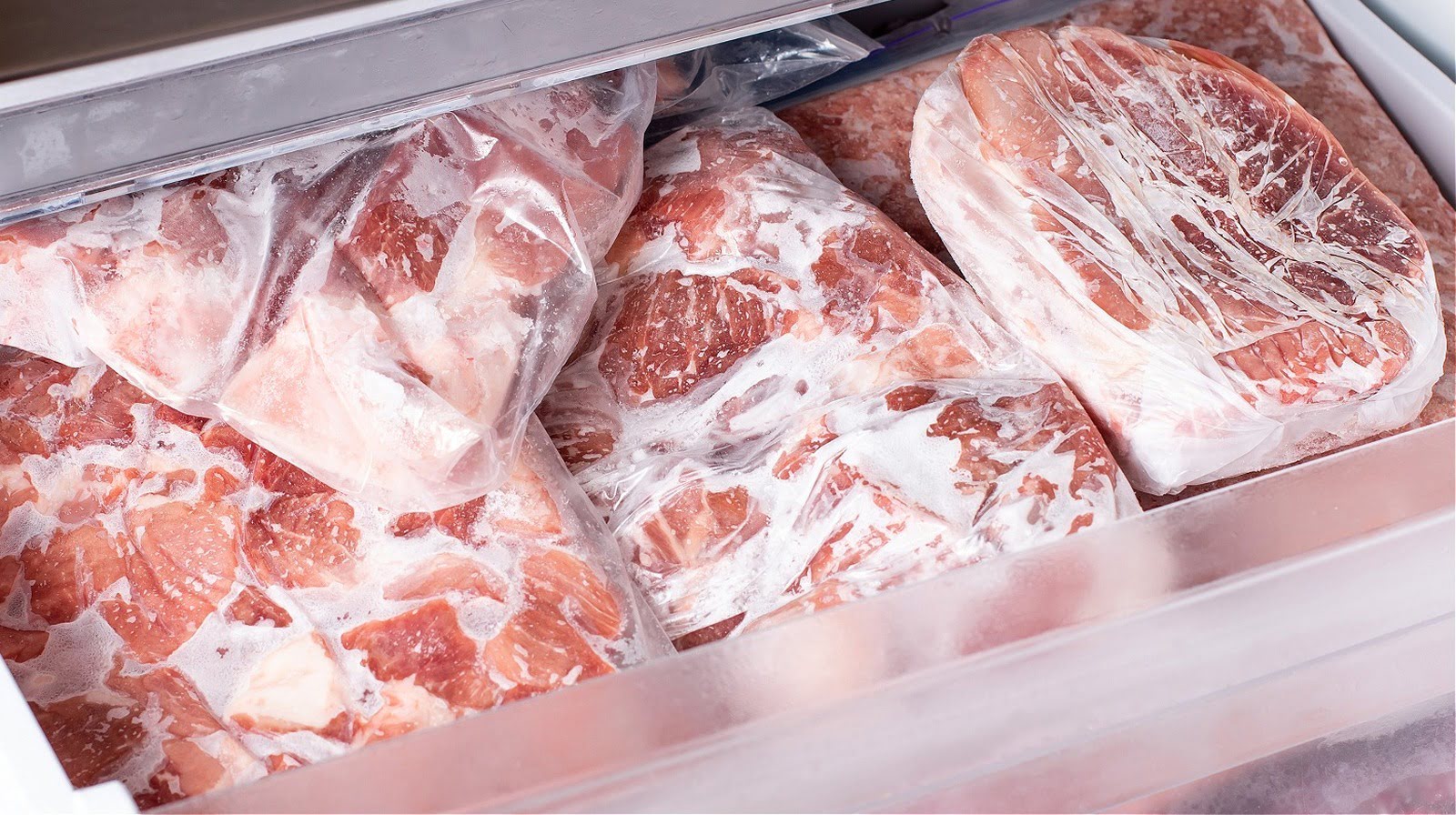

Articles
How Long Can Fish Last In The Freezer
Modified: February 23, 2024
Discover how long fish can last in the freezer with this informative article. Get expert tips and learn proper storage techniques to extend their freshness.
(Many of the links in this article redirect to a specific reviewed product. Your purchase of these products through affiliate links helps to generate commission for Storables.com, at no extra cost. Learn more)
Introduction
Freezing fish is a convenient way to preserve its freshness and extend its shelf life. Whether you’ve caught your own fish or purchased it from a supermarket or fish market, knowing how long fish can last in the freezer is essential for maintaining its quality and flavor.
When properly stored, frozen fish can stay safe to eat for an extended period. However, it’s important to note that the quality of frozen fish may deteriorate over time. This is why understanding the factors that affect the lifespan of fish in the freezer, as well as following proper freezing techniques, is crucial.
In this article, we will explore the various factors that can influence the longevity of fish in the freezer and provide recommendations for storage times for different types of fish. We will also discuss the proper techniques for freezing, signs of freezer burn and spoilage to look out for, safe thawing methods, and best practices for storing previously frozen fish.
By following these guidelines, you can ensure that your frozen fish remains at its best quality and taste, ready to be enjoyed whenever you’re in the mood for a delicious seafood dish.
Key Takeaways:
- Properly storing frozen fish is crucial for maintaining its quality. Factors like temperature, packaging, fish species, and freezing method all impact the longevity of fish in the freezer.
- Thaw frozen fish safely using methods like refrigerator thawing, cold water thawing, and microwave thawing. Properly store previously frozen fish to maintain its freshness and quality.
Factors Affecting the Lifespan of Fish in the Freezer
Several factors come into play when determining how long fish can last in the freezer before its quality starts to degrade. Understanding these factors will help you make informed decisions about storing your fish for optimal freshness. Here are the key factors to consider:
1. Temperature
The temperature of your freezer is crucial for preserving the quality of frozen fish. For best results, the freezer should be set at or below 0 degrees Fahrenheit (-18 degrees Celsius). This low temperature helps to prevent bacterial growth and slow down the deterioration of the fish’s texture and flavor.
2. Packaging
The way you package fish before freezing plays a significant role in maintaining its quality. Proper packaging helps to prevent freezer burn, which occurs when the fish is exposed to air. To protect the fish, wrap it tightly in moisture-proof or airtight packaging, such as plastic wrap or freezer bags. Alternatively, you can vacuum-seal the fish to remove excess air and provide an additional layer of protection.
3. Fish Quality
The quality of the fish before freezing can impact how long it will last in the freezer. Fresh, high-quality fish that has been properly handled and stored will generally have a longer freezer life compared to fish that is already on the verge of spoilage. Therefore, it is essential to choose fresh fish and freeze it as soon as possible after purchase or catch.
Read more: How Long Can Shrimp Last In The Freezer
4. Fish Species
Not all types of fish have the same freezer life. Some species are more delicate and prone to deteriorating quickly, while others can withstand longer freezing periods. Fatty fish like salmon and mackerel have a shorter freezer life compared to lean fish like cod and haddock. Research the recommended storage times for specific fish species to ensure optimum freshness.
5. Freezing Method
The way you freeze the fish can affect its quality and shelf life. It is best to freeze fish individually, ensuring they are not touching each other, to prevent them from clumping together. This allows for easier portioning and thawing later. Rapid freezing is also essential to preserve the texture and flavor of the fish. Consider using a blast freezer if you have access to one, or place the fish in the coldest part of your freezer to speed up the freezing process.
By taking these factors into account, you can optimize the lifespan of fish in your freezer and enjoy high-quality seafood dishes at your convenience.
Recommended Storage Times for Different Types of Fish
The storage times for frozen fish will vary depending on the type of fish and its quality before freezing. While fish can technically remain safe to eat indefinitely when frozen at 0 degrees Fahrenheit (-18 degrees Celsius) or lower, the quality may deteriorate over time. Here are some general recommendations for storing different types of fish in the freezer:
1. Lean Fish (e.g., cod, haddock, sole)
Lean fish typically have a longer freezer life compared to fatty fish. When properly stored, lean fish can stay at their best quality for up to 6-8 months in the freezer.
Read more: How Long Can Chocolate Last In The Freezer
2. Fatty Fish (e.g., salmon, mackerel, trout)
Fatty fish have a higher oil content, which can lead to quicker spoilage. It is best to consume fatty fish within 2-3 months of freezing to maintain their optimal quality. However, they can still be safe to eat for up to 6 months.
3. Shellfish (e.g., shrimp, scallops, lobster)
Shellfish generally have a shorter freezer life compared to fish. It is recommended to consume shellfish within 3-6 months of freezing for the best texture and flavor. However, they can remain safe to eat for up to a year when stored properly.
4. Smoked Fish (e.g., smoked salmon, smoked trout)
Smoked fish can be stored in the freezer for approximately 3 months without a significant loss in quality. It is best to consume smoked fish within this timeframe to enjoy its characteristic smoky flavor.
5. Prepared Fish Dishes (e.g., fish pies, fish cakes)
Prepared fish dishes, such as fish pies or fish cakes, can be stored in the freezer for up to 3 months. However, it is recommended to consume them within 1-2 months for the best taste and texture.
Keep in mind that these recommended storage times are just guidelines for maintaining the best quality. As long as frozen fish is stored at a consistently low temperature and shows no signs of spoilage or freezer burn, it should still be safe to eat beyond these timeframes.
By following these storage recommendations, you can ensure that your frozen fish retains its quality and taste, providing you with a delicious seafood option whenever you crave it.
Read more: How Long Can Butter Last In The Freezer
Proper Freezing Techniques for Fish
Properly freezing fish is essential for preserving its freshness and ensuring its quality when stored for an extended period. By following these techniques, you can maintain the taste and texture of the fish in the freezer:
1. Clean and Prepare the Fish
Start by cleaning and preparing the fish for freezing. Remove scales, guts, and any unwanted parts. Rinse the fish thoroughly under cold water to remove any traces of blood or dirt. Pat the fish dry with paper towels to remove excess moisture.
2. Wrap the Fish
Proper packaging is crucial for protecting the fish from freezer burn and maintaining its quality. Wrap the fish tightly in plastic wrap to create a moisture-proof barrier. Alternatively, place the fish in freezer bags and remove as much air as possible before sealing them. You can also use vacuum-sealed bags for an extra layer of protection.
3. Label and Date
Always label each package with the type of fish and the date it was frozen. This will help you keep track of the storage time and ensure you use the oldest fish first to maintain freshness.
Read more: How Long Can Cheese Last In The Freezer
4. Separate and Freeze Individually
Arrange the wrapped fish in a single layer on a baking sheet or tray, ensuring they are not touching each other. This will prevent them from clumping together during freezing. Place the tray in the coldest part of the freezer and allow the fish to freeze until firm.
5. Store in Freezer-Safe Containers
Once the individual fish are frozen solid, transfer them to freezer-safe containers or resealable freezer bags. This step helps to protect the fish from exposure to air and potential damage in the freezer. Make sure to remove as much air as possible from the containers or bags to prevent freezer burn.
6. Maintain Consistent Freezer Temperature
Always ensure that your freezer temperature is set at or below 0 degrees Fahrenheit (-18 degrees Celsius) to maintain the quality of the fish. Avoid frequent temperature fluctuations by keeping the freezer door closed as much as possible.
By following these proper freezing techniques, you can significantly extend the lifespan of your fish in the freezer while preserving its flavor and texture. As a result, you’ll have a supply of high-quality fish ready to be cooked and enjoyed whenever you desire.
Signs of Freezer Burn and Spoilage in Frozen Fish
While properly frozen fish can retain its quality for an extended period, it is still susceptible to freezer burn and spoilage if not stored correctly. It’s essential to know the signs of these issues to ensure that the fish you consume is safe and enjoyable. Here are the key indicators of freezer burn and spoilage in frozen fish:
Read more: How Long Can Bacon Last In The Freezer
1. Freezer Burn
Freezer burn occurs when the surface of the fish becomes dehydrated in the freezer. It results in dry, discolored patches on the flesh. Look for these signs of freezer burn:
- Dull, whitish or grayish color on the surface of the fish
- Brittle or dry texture
- Leathery or toughened areas
- Presence of ice crystals or frost on the fish
If you notice any of these signs, the affected areas may have a change in flavor and texture, but they are generally safe to eat. Simply cut away the affected portions before cooking to maintain the quality of the remaining fish.
2. Spoilage
In addition to freezer burn, frozen fish can also spoil over time. Spoiled fish can be unsafe to eat and may also give off a foul odor. Here are the signs of spoilage to watch out for:
- Strong, pungent, or ammonia-like smell
- Discoloration, such as a greenish or yellowish tinge
- Slime or excessive moisture on the surface
- Texture that feels mushy or slimy
If you observe any of these signs, it is best to discard the fish as it may have become contaminated with harmful bacteria and is no longer safe to consume.
To minimize the risk of freezer burn and spoilage, ensure that the fish is properly wrapped and sealed to prevent air exposure. It is also important to store fish at a consistent temperature within the freezer and to use the oldest fish first to avoid long periods of storage.
By being vigilant and recognizing these signs, you can ensure that the frozen fish you consume is of the highest quality and safe for consumption, leading to delicious seafood dishes every time.
Thawing Frozen Fish Safely
Thawing frozen fish properly is crucial to maintain its quality and ensure that it remains safe to eat. Here are some safe methods to thaw frozen fish:
1. Refrigerator Thawing
Thawing fish in the refrigerator is the safest method, although it requires a bit of time. Place the wrapped fish on a plate or tray and allow it to thaw in the refrigerator. This slow thawing process promotes even defrosting and helps preserve the texture and flavor of the fish. It is recommended to place a plate or tray under the fish to catch any potential drips.
Keep in mind that thawing fish in the refrigerator will take several hours or overnight, depending on the size and thickness of the fish. Plan ahead and allow sufficient time for the fish to thaw completely before cooking.
Read more: How Long Can Bananas Last In The Freezer
2. Cold Water Thawing
If you need to thaw fish more quickly, the cold water thawing method can be used. Ensure that the fish is tightly sealed in a leak-proof plastic bag to prevent water from entering and potentially diluting its flavor. Submerge the fish in cold water, changing the water every 30 minutes to maintain a constant temperature. Use cold tap water rather than warm water to prevent the fish from reaching an unsafe temperature.
This method is faster than refrigerator thawing and can take approximately 1-2 hours depending on the size and thickness of the fish. Once the fish has thawed completely, cook it immediately to avoid any bacterial growth.
3. Microwave Thawing
If you’re in a rush, you can use the microwave to thaw fish. However, this method should be used carefully to prevent partially cooking the fish. Use the defrost setting on your microwave and follow the manufacturer’s instructions for thawing fish. Thawing times will vary depending on the size and power of your microwave, so monitor the fish closely to prevent any cooking.
Once the fish is partially thawed in the microwave, cook it immediately to ensure safe consumption and to prevent any bacterial growth caused by uneven thawing.
Avoid thawing fish at room temperature, as this can lead to bacterial growth and spoilage. It’s crucial to prioritize food safety by thawing fish using the methods mentioned above.
Remember, once fish is thawed, it should be used promptly and not refrozen unless it has been cooked thoroughly. By thawing frozen fish safely, you can maintain its quality and enjoy delicious seafood dishes with peace of mind.
Best Practices for Storing Previously Frozen Fish
After thawing and enjoying previously frozen fish, you may find yourself with leftovers that need to be stored properly to maintain their freshness. Here are some best practices for storing previously frozen fish:
1. Proper Packaging
When storing previously frozen fish, it is essential to ensure proper packaging to prevent contamination and maintain quality. Place the leftover fish in an airtight container or wrap it tightly in plastic wrap or aluminum foil. Make sure there is no exposure to air, as this can cause freezer burn and affect the taste and texture of the fish.
Read more: How Long Can Spinach Last In The Freezer
2. Labeling and Dating
Just like with freshly frozen fish, it’s important to label the containers or packages with the type of fish and the date it was stored. This helps you keep track of how long the leftovers have been stored and allows you to use the oldest fish first to prevent waste and ensure freshness.
3. Refrigerator Storage
If you plan to consume the leftover fish within a few days, storing it in the refrigerator is the best option. Place the tightly sealed container in the coldest part of the refrigerator and ensure that it is not in contact with other perishable foods. Consume the leftover fish within 2-3 days to maintain the best quality and flavor.
4. Freezing for longer storage
If you won’t be able to consume the leftover fish within a few days, consider freezing it again for longer storage. Properly package the fish as mentioned earlier and place it in the freezer. Keep in mind that the quality of the fish may be slightly compromised after being thawed and re-frozen, so it’s best to use previously frozen leftovers within 1-2 months for optimal taste and texture.
5. Safety precautions
When working with previously frozen fish, always follow food safety guidelines. Only store leftovers that have been properly thawed and cooked before. Never refreeze fish that has been thawed and stored raw. Additionally, ensure that the fish has been stored at a safe temperature and shows no signs of spoilage or freezer burn before consuming.
By following these best practices, you can store previously frozen fish properly and enjoy its taste and quality when you’re ready to consume it. Remember to prioritize food safety and consume the fish within recommended timeframes for the best dining experience.
Read more: How Long Can A Turkey Last In The Freezer
Conclusion
Properly storing and handling frozen fish is essential for preserving its freshness, flavor, and quality. By understanding the factors that affect the lifespan of fish in the freezer, following recommended storage times for different types of fish, practicing proper freezing techniques, recognizing signs of freezer burn and spoilage, and safely thawing and storing previously frozen fish, you can ensure that your seafood remains delicious and safe to consume.
Remember to set your freezer at or below 0 degrees Fahrenheit (-18 degrees Celsius) and maintain a consistent temperature to prevent bacterial growth and maintain the quality of the fish. Properly package fish in airtight and moisture-proof wrapping to prevent freezer burn, and always label and date the packages for easy reference.
When thawing frozen fish, opt for the refrigerator method for gradual and even thawing, or use the cold water method for quicker thawing. Avoid thawing fish at room temperature to prevent bacterial growth and spoilage.
Lastly, when storing previously frozen fish, ensure proper packaging, refrigeration, and freezing techniques. Consume leftover fish within a few days if stored in the refrigerator, and within 1-2 months if stored in the freezer for longer periods.
By following these best practices, you can enjoy the convenience of frozen fish without compromising its quality. From lean fish to fatty fish, shellfish, and even prepared fish dishes, you can savor the taste of fresh seafood whenever you desire.
So, next time you have a bounty of fish, whether you caught it yourself or purchased it from a market, apply these guidelines to store it properly in the freezer. By doing so, you can prolong the shelf life of the fish and relish in culinary creations that showcase the deliciousness of seafood for months to come.
Frequently Asked Questions about How Long Can Fish Last In The Freezer
Was this page helpful?
At Storables.com, we guarantee accurate and reliable information. Our content, validated by Expert Board Contributors, is crafted following stringent Editorial Policies. We're committed to providing you with well-researched, expert-backed insights for all your informational needs.








0 thoughts on “How Long Can Fish Last In The Freezer”